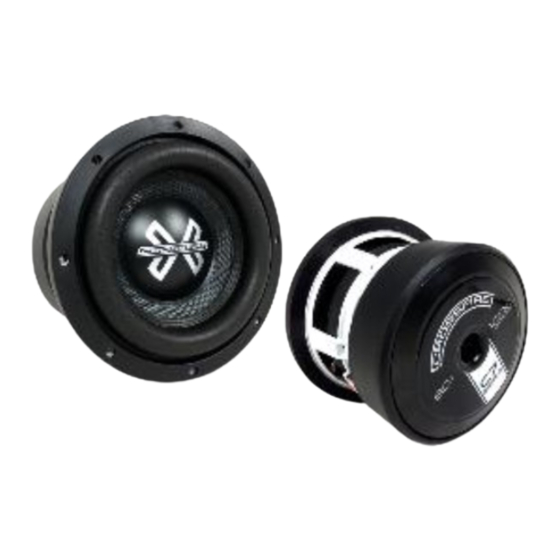
Table of Contents
Advertisement
Quick Links
SUBWOOFER MANUAL
SUBWOOFER MANUAL
Thanks for buying our product! Product information follows; please read it carefully to get the most out of your
subwoofers. Any questions, you can contact technical support:
Phone 972-570-0800; Email: tech@crossfi recaraudio.com
Enjoy!
Subwoofer Power Rating:
Subwoofer Power Rating:
Power handling for subwoofers depends on the conditions used. How loudly you play, what type of music and how hard
you drive the amplifi er are more important than any numbers-but of course, some kind of numeric guideline is necessary for
convenience. Therefore, Crossfi re rates as follows:
Nominal Power Handling: This amount of RMS amplifi er power should not cause damage to a subwoofer in a
recommended enclosure-so long as the amplifi er is not clipped.*
Maximum Power Handling: This amount of RMS amplifi er power driving the subwoofer at maximum volume continuously
could cause damage over time and should be used with caution and without clipping the amp.
Notes On Amplifi er Power:
The important rating of an amp is RMS power. If this spec is not exaggerated, it is how many watts the amp can output
continuously without distortion. Other specs ("peak" ; "maximum") are not very meaningful in most cases. How does this match a
subwoofer's power rating? Read on...
Notes On Subwoofer Limits:
Subs have two limitations: mechanical and thermal. Crossfi re combines these into the ratings explained at the top.
Thermal power handling of the woofer is basically how many watts you can pump into it before it burns or melts:
-Amps' RMS power similar to the subwoofers rating should a good match providing the amp is not clipped
-Amp's RMS power much more than subwoofers rating: could damage the sub unless gains are carefully set to prevent the
amplifi ers ever clipping.
-Amp's RMS power much less than the subwoofers rating: could still damage the sub if the amp is clipped.
Mechanical power handling means how far the cone can move before physical parts hit or deform ("bottoming out"). At very
low frequencies, it does not take much power to move the subwoofer cone a lot, so even low powered amplifi ers could damage
the subwoofer. The enclosure affects how easy it is to hit the mechanical limits: please see notes on a later page.
*Amplifi er Clipping and Dead Subwoofers:
When "Clipped" the amplifi er tries to put out more power than it is capable of, and the output waveform fl attens out, no longer
following the music. Viewed on an oscilloscope, it looks like the music waveform has had the tops "clipped off" with scissors.
Under these conditions, an amplifi ers could put out over twice it's rated RMS power, causing a subwoofer to overheat.
Additionally, a clipped amplifi er can generate DC currents which will drive the subwoofers coil out of position: it may burn and/or
hit mechanical limits more easily. A clipping amp will sound highly distorted and crackly. A sub hitting it's mechanical limits tends
to sound like a jackhammer or woodpecker. These sounds often indicate damage could be imminent.
- Bottom line? If it sounds not merely loud but nasty, TURN IT DOWN before something breaks!
C7-sERIES
C7-sERIES
Advertisement
Table of Contents

Summary of Contents for Crossfire C7 series
- Page 1 C7-sERIES C7-sERIES SUBWOOFER MANUAL SUBWOOFER MANUAL Thanks for buying our product! Product information follows; please read it carefully to get the most out of your subwoofers. Any questions, you can contact technical support: Phone 972-570-0800; Email: tech@crossfi recaraudio.com Enjoy! Subwoofer Power Rating: Subwoofer Power Rating: Power handling for subwoofers depends on the conditions used.
- Page 2 SPECS AND DIMENSIONS M ode l : C 7 8 D 1 C 7 8 D 2 C 7 10 D 1 C 7 10 D 2 Nominal Size 8" 8" 10" 10" Outer Diameter (OD) 8.66" / 220mm 8.66" / 220mm 10.5"...
- Page 3 SPECS AND DIMENSIONS M ode l : C 7 12 D 1 C 7 12 D 2 C 7 15 D 1 C 7 15 D 2 Nominal Size 12" 12" 15" 15" Outer Diameter (OD) 12.6" / 320mm 12.6" / 320mm 15.6"...
- Page 4 BOX DESIGN NOTES Sealed Boxes VS Ported Boxes: Sealed Boxes offer the most protection from mechanical damage, plus can offer the most accurate sound quality if not undersized. Exact size is not too critical and can be adjusted by stuffi ng (see below). Response decreases gradually at low frequencies giving a nearly fl...
- Page 5 RECOMENDED PORTED ENCLOSURES C 7 8 D 1 C 7 8 D 2 C 7 10 D 1 C 7 10 D 2 M ode l : 1.5ft 1.5ft Internal Volume (Net) 0.65ft 0.65ft 34Hz 34Hz Port Tuning Frequency 38Hz 38Hz Port Area 8 sq inches...
- Page 6 DUAL VOICE COIL WIRING OPTIONS Speaker Wiring Comments: For each individual subwoofer, it doesn’t matter if you wire the coils in series or parallel. However, don’t wire in series with another subwoofer - that results in less than optimum power sharing and sound. Likewise, don’t wire just one coil of a dual coil setup.
- Page 7 All returns must be sent with an RA # on the outside of the box. Any and all products sent without an RA# will be refused. An RA # can be obtained by calling or faxing Crossfire and requesting the number.
- Page 8 3247 Story Rd West, Irving TX 75038 Ph: (972) 570-0800 | Fax: (972) 570-2200 www.crossfi recaraudio.com...

Need help?
Do you have a question about the C7 series and is the answer not in the manual?
Questions and answers